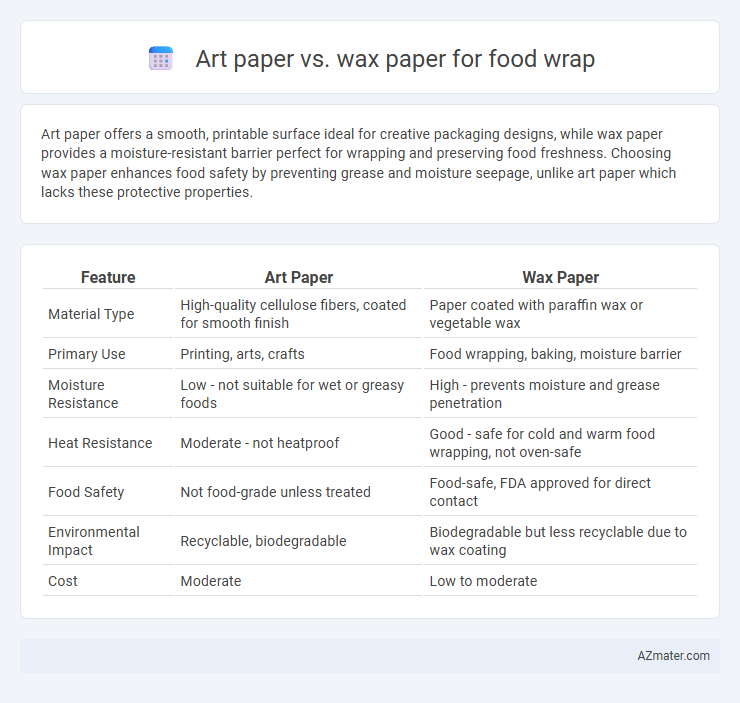Art paper offers a smooth, printable surface ideal for creative packaging designs, while wax paper provides a moisture-resistant barrier perfect for wrapping and preserving food freshness. Choosing wax paper enhances food safety by preventing grease and moisture seepage, unlike art paper which lacks these protective properties.
Table of Comparison
| Feature | Art Paper | Wax Paper |
|---|---|---|
| Material Type | High-quality cellulose fibers, coated for smooth finish | Paper coated with paraffin wax or vegetable wax |
| Primary Use | Printing, arts, crafts | Food wrapping, baking, moisture barrier |
| Moisture Resistance | Low - not suitable for wet or greasy foods | High - prevents moisture and grease penetration |
| Heat Resistance | Moderate - not heatproof | Good - safe for cold and warm food wrapping, not oven-safe |
| Food Safety | Not food-grade unless treated | Food-safe, FDA approved for direct contact |
| Environmental Impact | Recyclable, biodegradable | Biodegradable but less recyclable due to wax coating |
| Cost | Moderate | Low to moderate |
Introduction: Art Paper vs Wax Paper for Food Wrapping
Art paper offers a porous surface that absorbs oils and moisture, making it suitable for dry food wrapping but less effective against leaks and spills. Wax paper features a thin layer of food-grade wax on both sides, providing a moisture-resistant barrier ideal for wrapping greasy or wet foods. Choosing between art paper and wax paper depends on the specific food type and the need for moisture protection during storage or transport.
Material Composition: Comparing Art Paper and Wax Paper
Art paper is primarily made from cellulose fibers with a smooth surface designed for printing and painting, lacking any moisture-resistant coating. Wax paper, on the other hand, consists of paper coated with a thin layer of paraffin wax, providing a moisture barrier that makes it suitable for wrapping food and preventing sticking. The presence of wax in wax paper makes it water-resistant and slightly grease-resistant, while art paper remains absorbent and unsuitable for direct food contact or moisture protection.
Food Safety and Non-Toxic Properties
Art paper is not recommended for food wrapping due to its lack of food safety certification and potential chemical coatings that can leach harmful substances into food. Wax paper, coated with a thin layer of food-grade paraffin wax, provides a safer, non-toxic barrier suitable for food contact and moisture resistance. Choosing wax paper ensures compliance with food safety standards and minimizes the risk of contamination or ingestion of toxic chemicals.
Moisture and Grease Resistance
Art paper offers moderate moisture resistance but lacks effective grease resistance, making it less suitable for wrapping oily or greasy foods. Wax paper, coated with a thin layer of paraffin wax, provides superior moisture and grease resistance, preventing leaks and maintaining food quality. This property makes wax paper ideal for wrapping meats, cheeses, and other moisture-prone items, ensuring better preservation and cleanliness.
Breathability and Freshness Preservation
Art paper offers moderate breathability, allowing some air circulation that helps maintain food freshness by reducing moisture buildup, but it may not provide a perfect seal against air exposure. Wax paper features a coating of paraffin wax, rendering it less breathable and more moisture-resistant, which helps to lock in freshness and prevent food from drying out. The choice between art paper and wax paper for food wrap depends on the needed balance between breathability to avoid sogginess and airtight preservation for longer-lasting freshness.
Printability and Aesthetic Appeal
Art paper offers superior printability with vibrant, high-resolution images due to its smooth, coated surface ideal for intricate branding and detailed designs. Wax paper, coated with a thin layer of wax, has limited print quality, often resulting in duller visuals and less precise graphics. Aesthetically, art paper provides a polished, professional look suited for premium food packaging, whereas wax paper's translucent, rustic appearance is better for casual or eco-friendly presentation.
Environmental Impact and Sustainability
Art paper, often coated with plastic or chemical additives, poses challenges for recycling and contributes to landfill waste, whereas wax paper is biodegradable and compostable due to its natural wax coating, making it a more sustainable choice for food wrapping. The production of wax paper generally involves less environmental pollution and reduced carbon emissions compared to art paper manufacturing processes. Choosing wax paper supports eco-friendly practices by minimizing plastic waste and promoting organic decomposition in waste management systems.
Cost Effectiveness and Availability
Art paper tends to be more expensive and less readily available compared to wax paper, which is widely accessible in most grocery stores at a lower cost. Wax paper offers superior cost-effectiveness for food wrapping due to its moisture-resistant coating, which helps maintain food freshness without the need for additional packaging materials. The durability and common use of wax paper make it a preferred choice for households and food businesses seeking affordable and easy-to-find food wrap solutions.
Suitability for Different Types of Food
Art paper is ideal for dry foods like sandwiches, cookies, and pastries due to its smooth surface and ability to prevent moisture absorption, keeping contents fresh without sogginess. Wax paper offers a moisture-resistant barrier suitable for wrapping greasy or moist foods such as cheese, raw meats, and marinated items, preventing leaks and maintaining cleanliness. For foods requiring both breathability and protection, art paper supports optimal freshness, while wax paper excels in handling higher moisture or oil content.
Final Recommendation: Choosing the Best Food Wrap
Art paper offers a smooth, absorbent surface ideal for wrapping dry foods, while wax paper provides a moisture-resistant barrier perfect for protecting moist or greasy items. For optimal food wrap, select wax paper when preserving freshness and preventing leaks, especially with sandwiches and baked goods. Art paper suits situations requiring breathability, like wrapping dry snacks, but wax paper remains the top choice for versatile, effective food preservation.

Infographic: Art paper vs Wax paper for Food wrap
 azmater.com
azmater.com